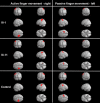Congenital Mirror Movements in a New Italian Family
- PMID: 30713853
- PMCID: PMC6353446
- DOI: 10.1002/mdc3.12066
Congenital Mirror Movements in a New Italian Family
Abstract
Mirror movements (MMs) occur on the contralateral side of a limb being used intentionally. Because few families with congenital MMs and no other neurological signs have been reported, the underlying mechanisms of MMs are still not entirely clear. We report on the clinical, genetic, neurophysiological and neuroimaging findings of 10 of 26 living members of a novel four-generation family with congenital MMs. DCC and RAD51 were sequenced in affected members of the family. Five of the ten subjects with MMs underwent neurophysiological and neuroimaging evaluations. The neurophysiological evaluation consisted of electromyographic (EMG) mirror recordings, investigations of corticospinal excitability, and analysis of interhemispheric inhibition using transcranial magnetic stimulation techniques. The neuroimaging evaluation included functional MRI during finger movements. Eight (all females) of the ten members examined presented MMs of varying degrees at the clinical assessment. Transmission of MMs appears to have occurred according to an autosomal-dominant fashion with variable expression. No mutation in DCC or RAD51 was identified. EMG mirror activity was higher in MM subjects than in healthy controls. Short-latency interhemispheric inhibition was reduced in MM subjects. Ipsilateral motor-evoked potentials were detectable in the most severe case. The neuroimaging evaluation did not disclose any significant abnormalities in MM subjects. The variability of the clinical features of this family, and the lack of known genetic abnormalities, suggests that MMs are heterogeneous disorders. The pathophysiological mechanisms of MMs include abnormalities of transcallosal inhibition and corticospinal decussation.
Keywords: corticospinal excitability; electromyography; functional magnetic resonance imaging; interhemispheric inhibition; mirror movements; neurophysiology; transcranial magnetic stimulation.
Figures




References
-
- Cincotta M, Ziemann U. Neurophysiology of unimanual motor control and mirror movements. Clin Neurophysiol 2008;119:744–762. - PubMed
-
- Merello M, Carpintiero S, Cammarota A, Meli F, Leiguarda R. Bilateral mirror writing movements (mirror dystonia) in a patient with writer's cramp: functional correlates. Mov Disord 2006;21:683–689. - PubMed
-
- Ottaviani D, Tiple D, Suppa A, et al. Mirror movements in patients with Parkinson's disease. Mov Disord 2008;23:253–258. - PubMed
-
- Gunderson CH, Solitare GB. Mirror movements in patients with the Klippel‐Feil syndrome. Neuropathologic observations. Arch Neurol 1968;18:675–679. - PubMed
LinkOut - more resources
Full Text Sources
Research Materials

